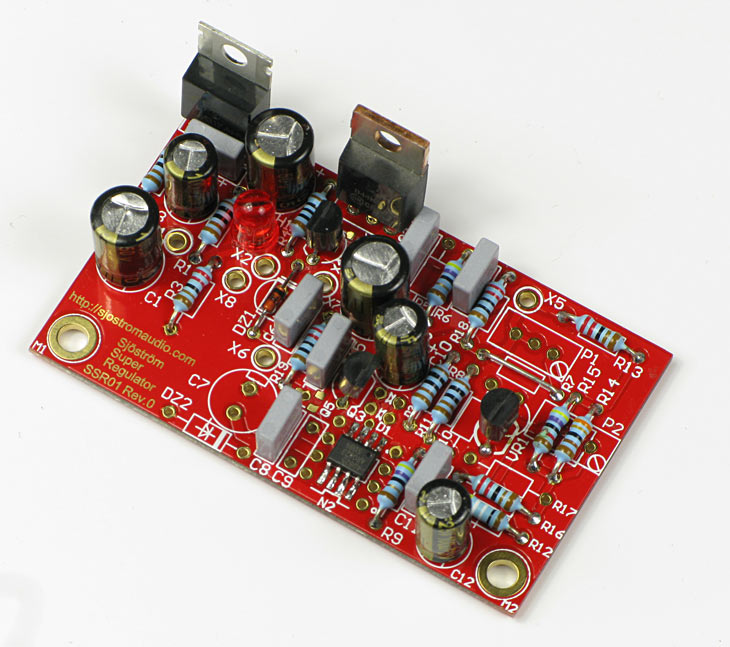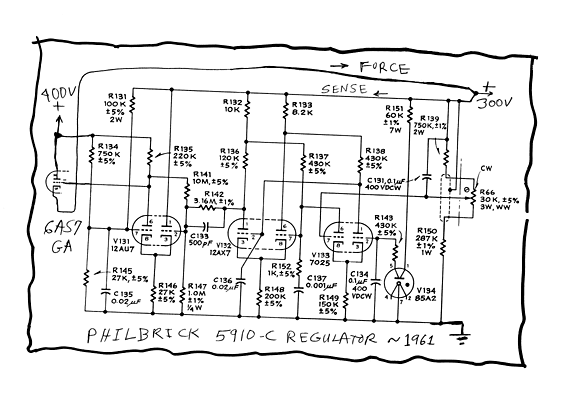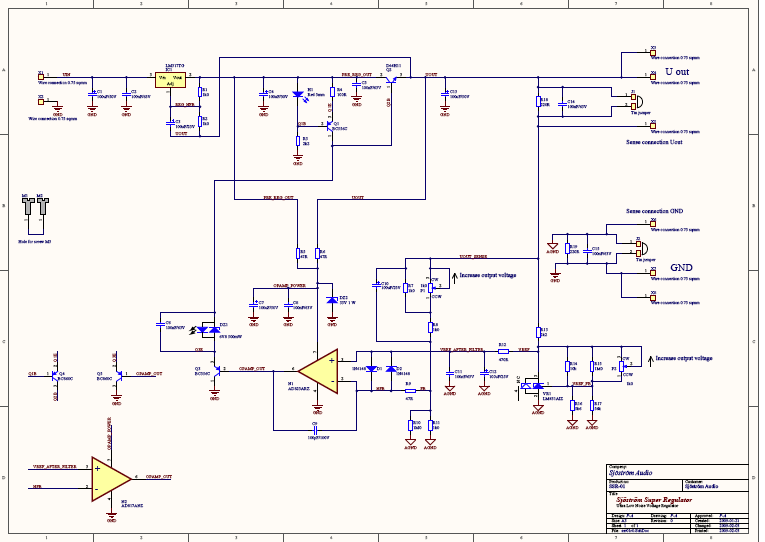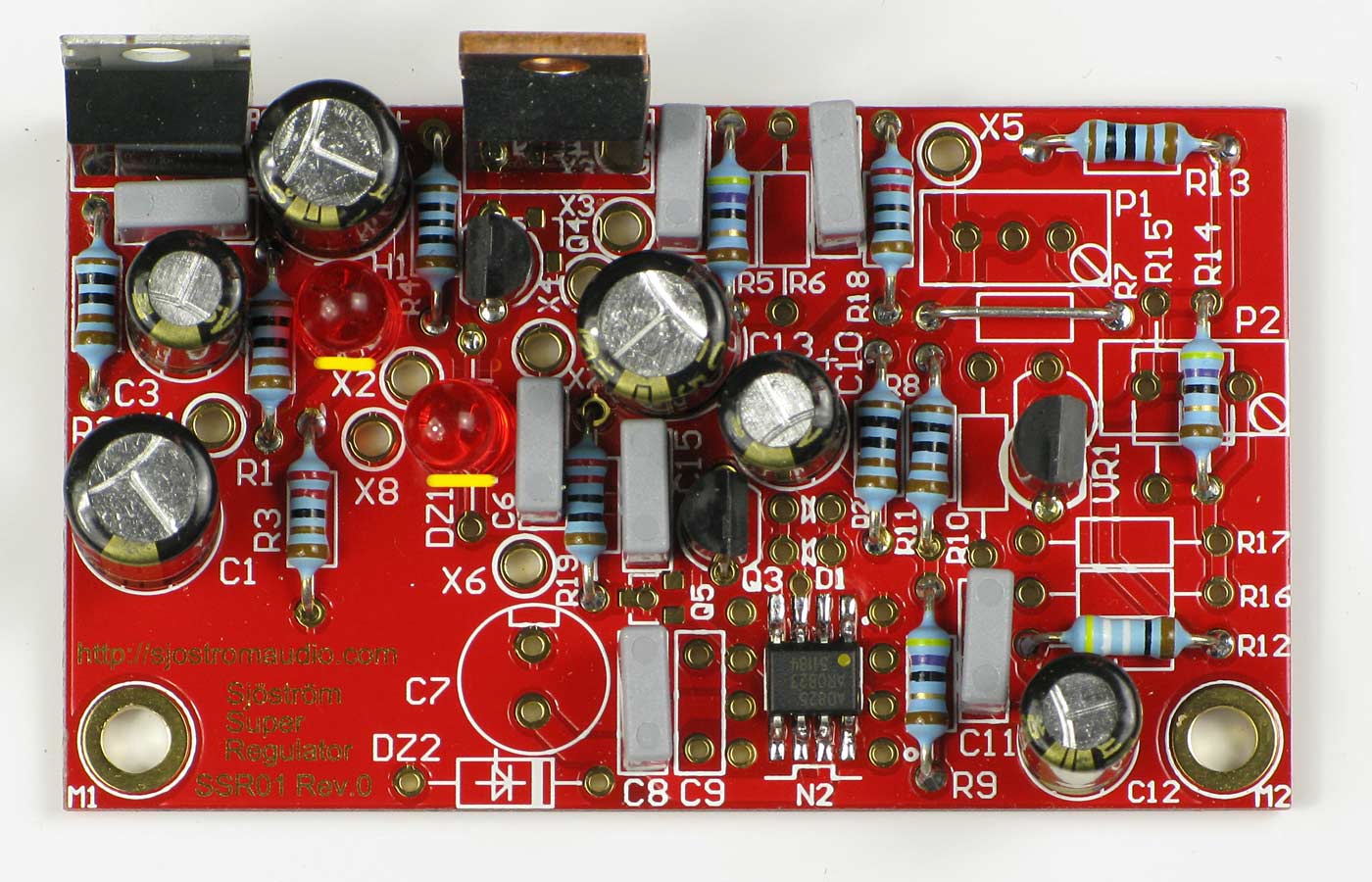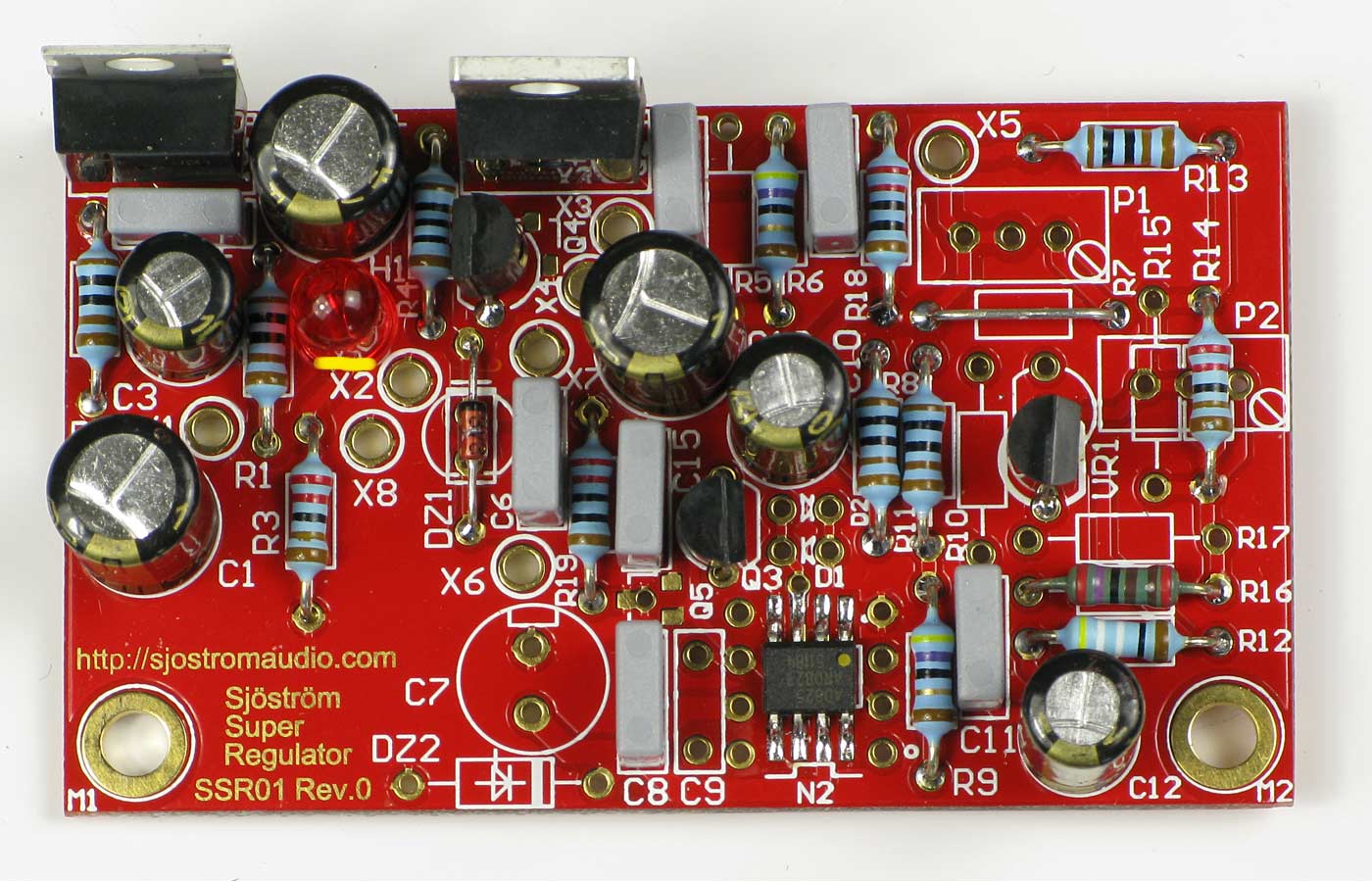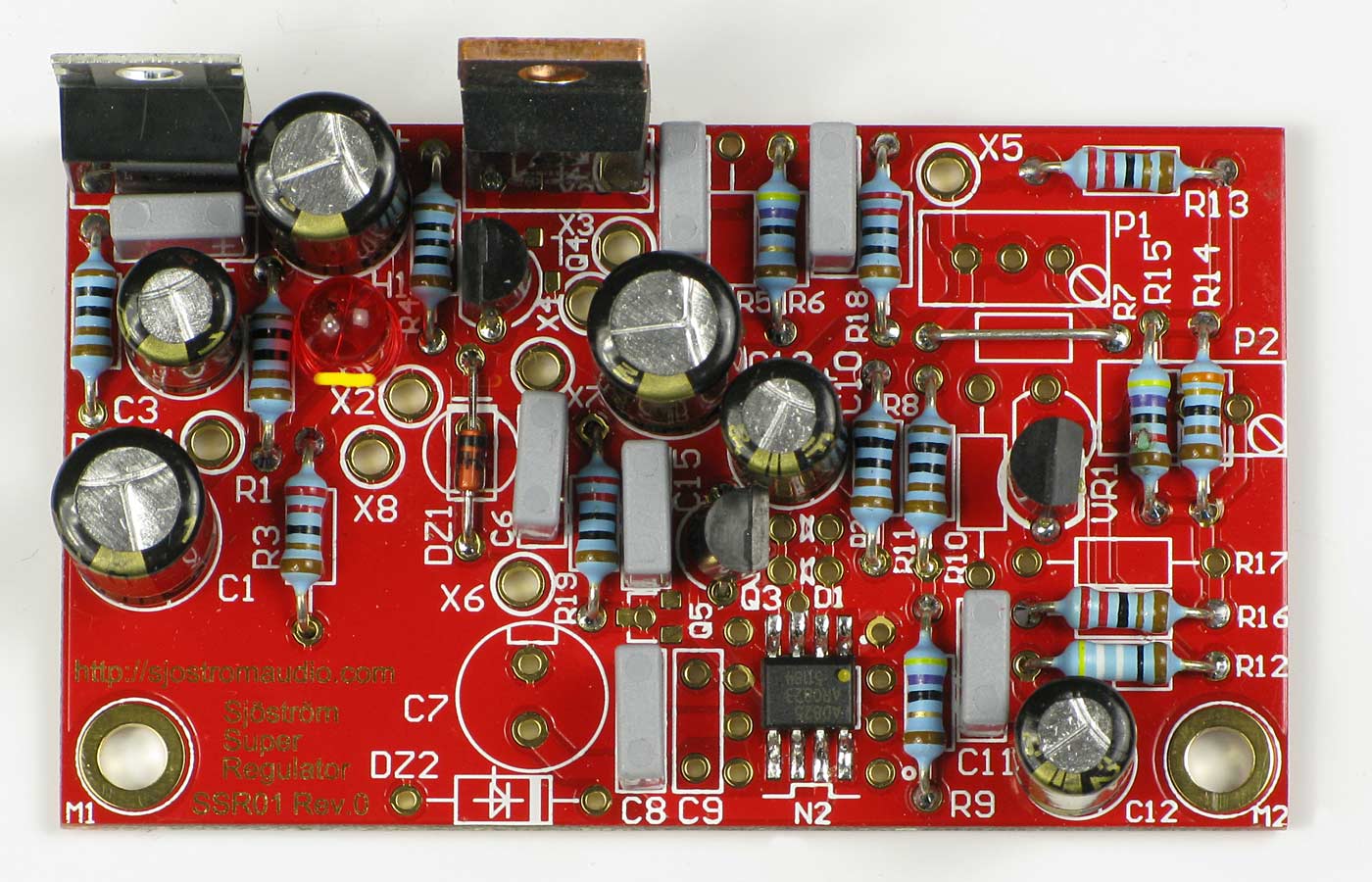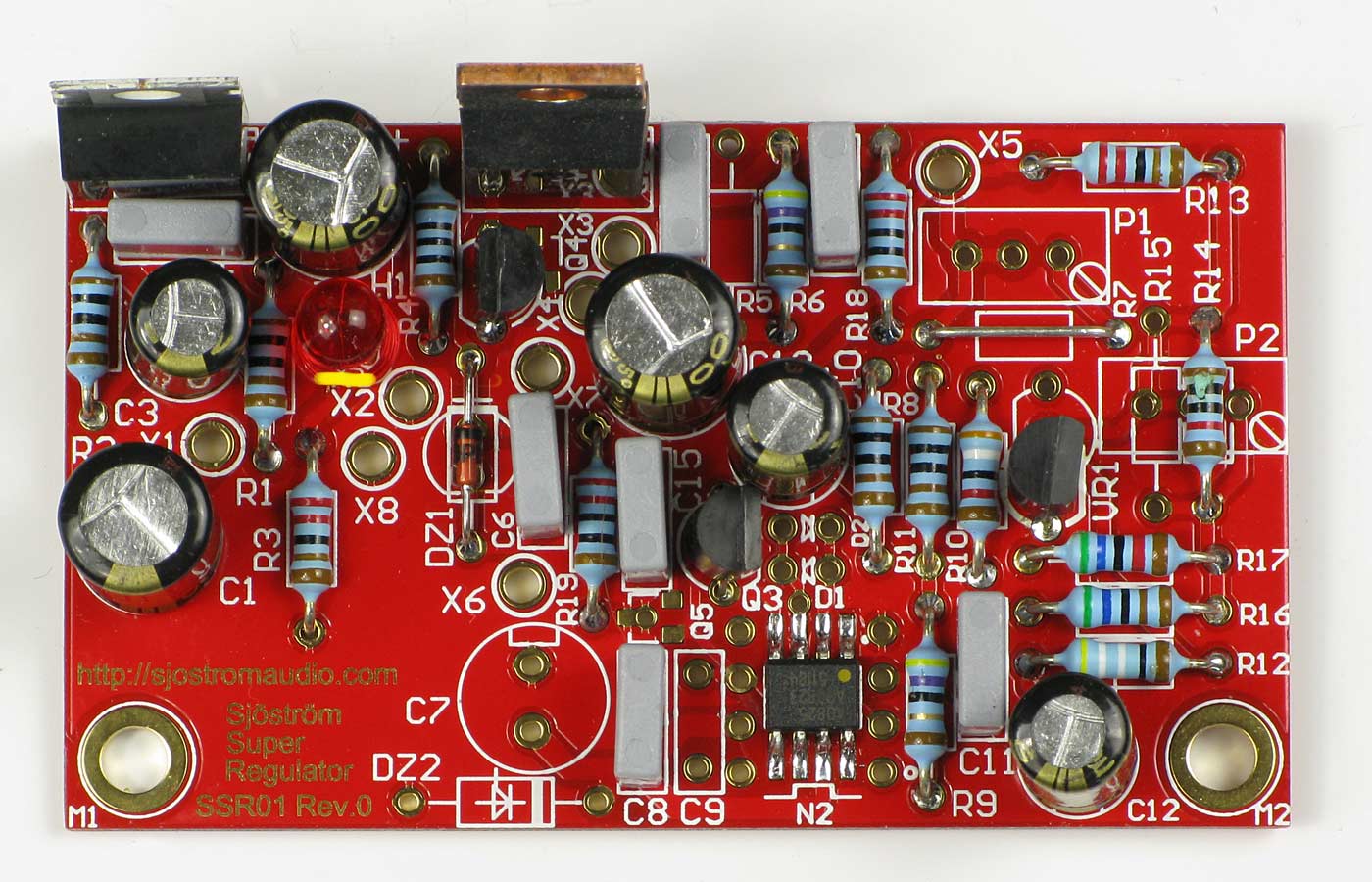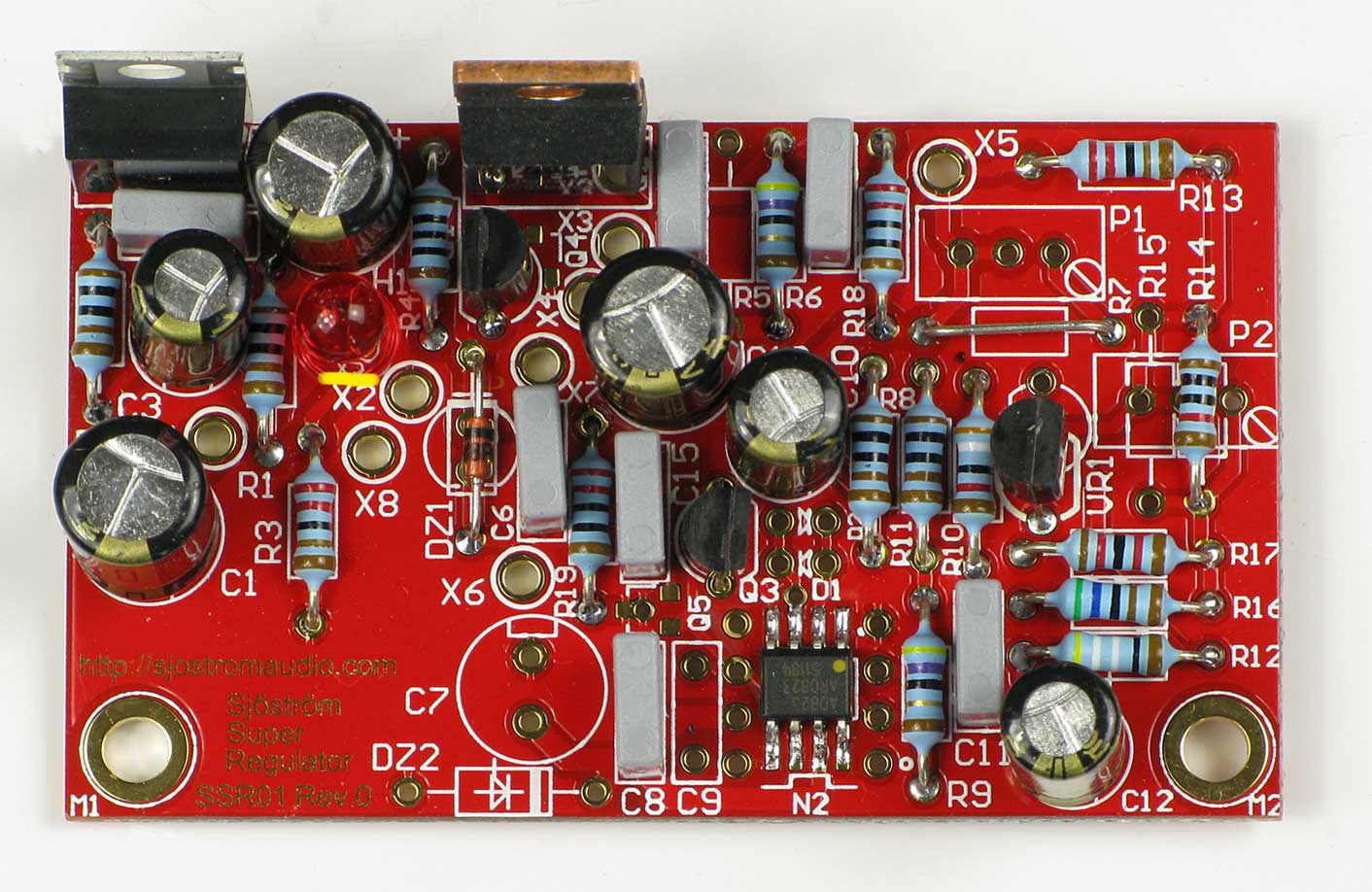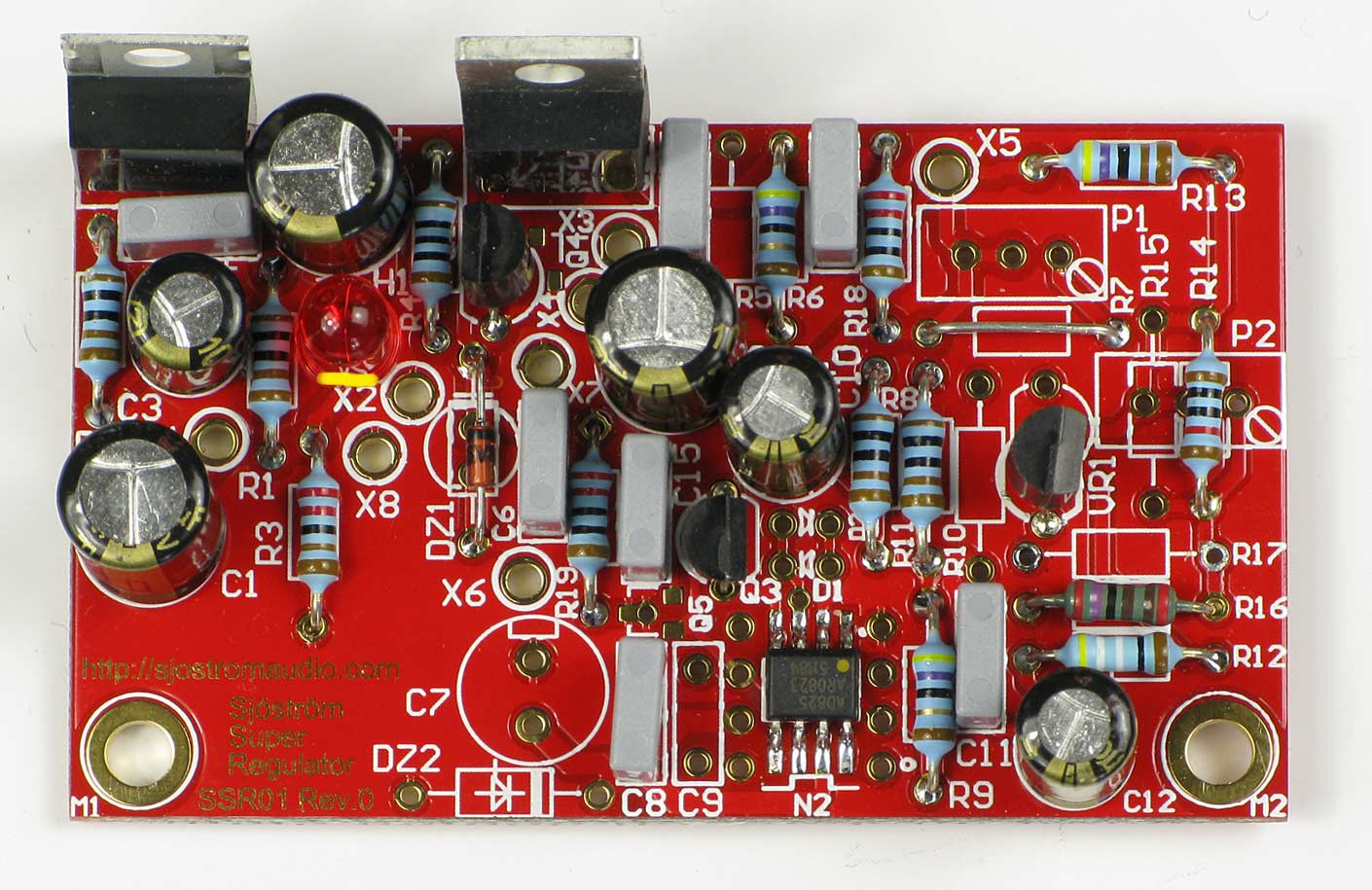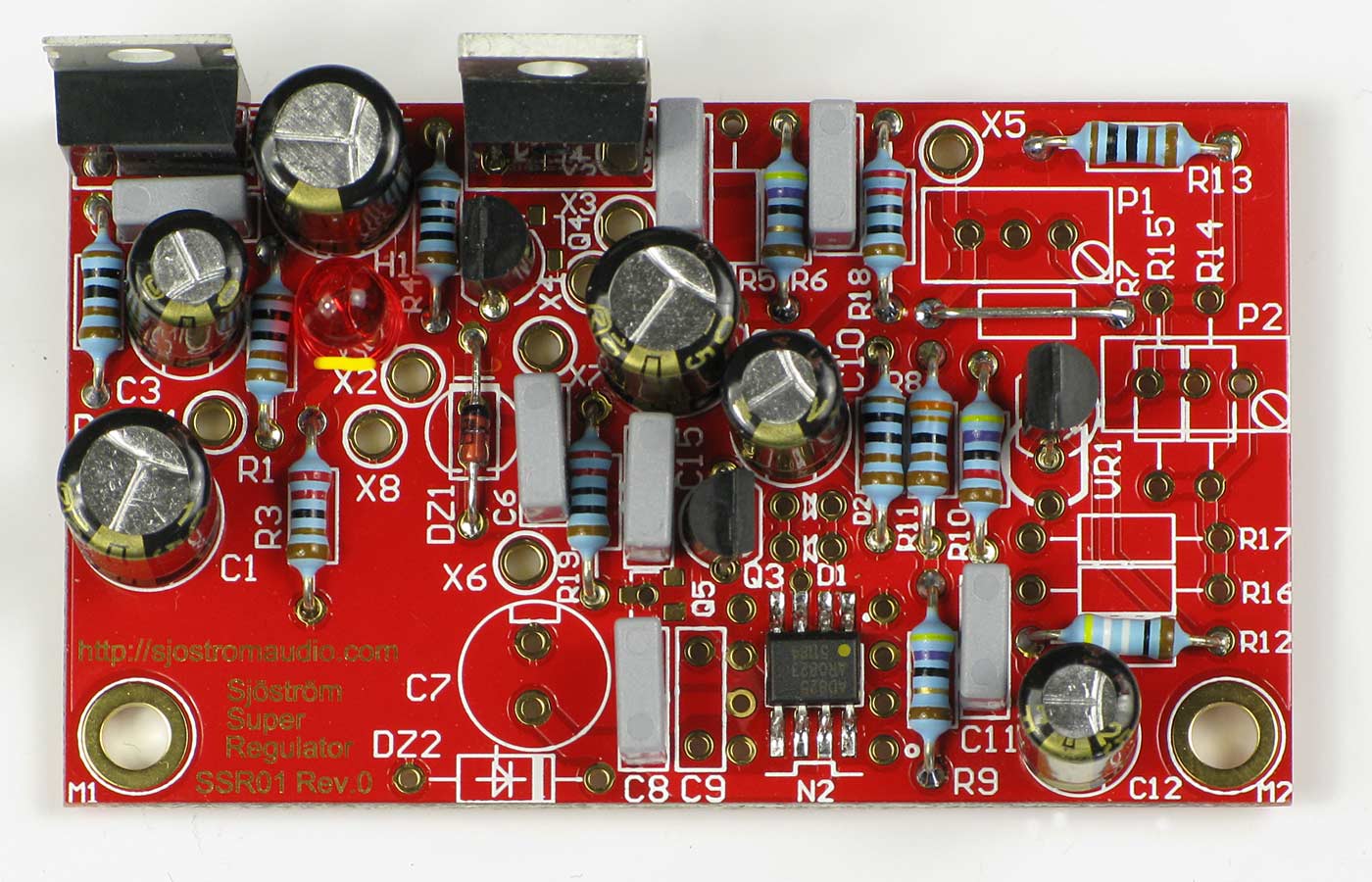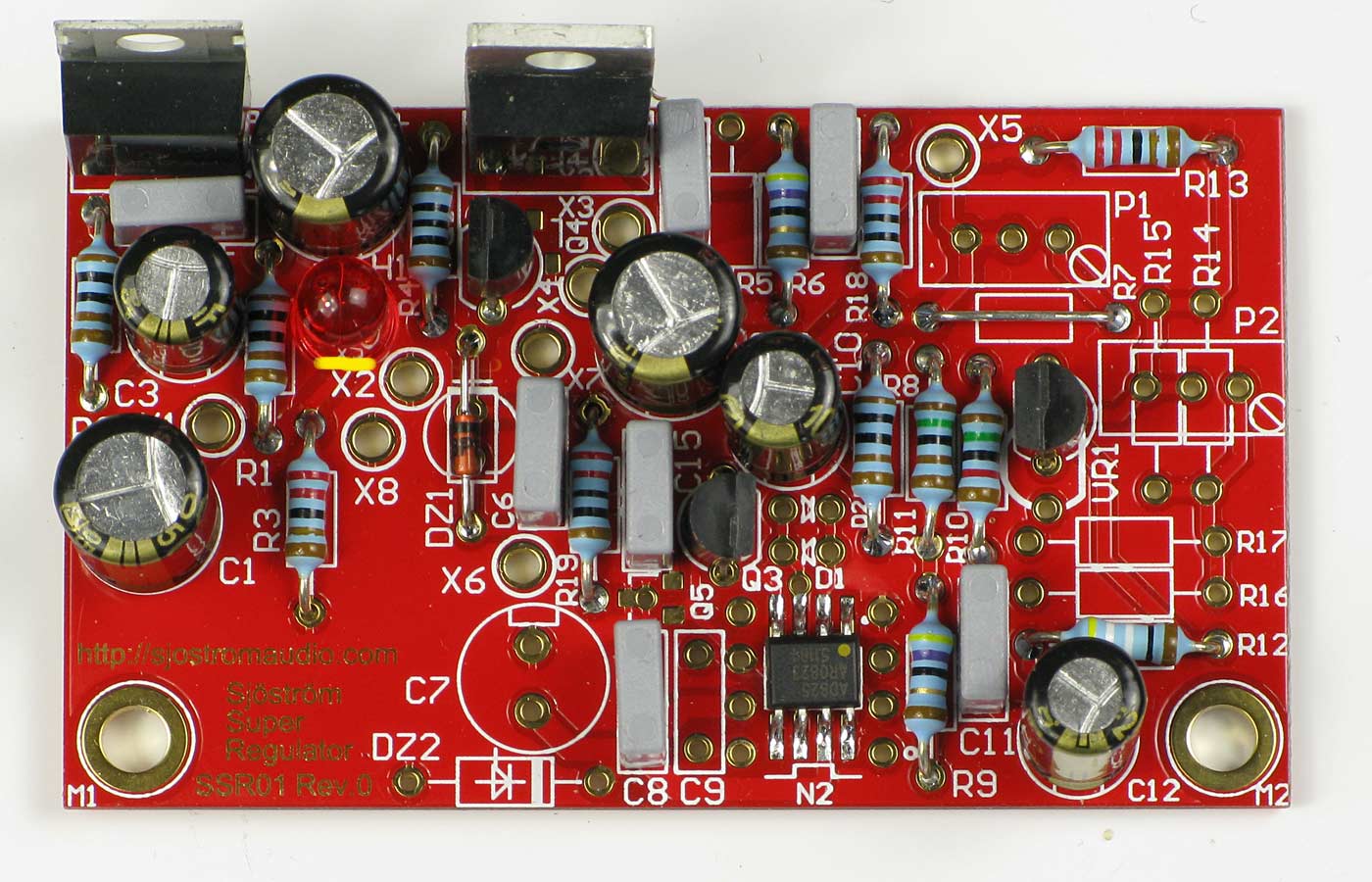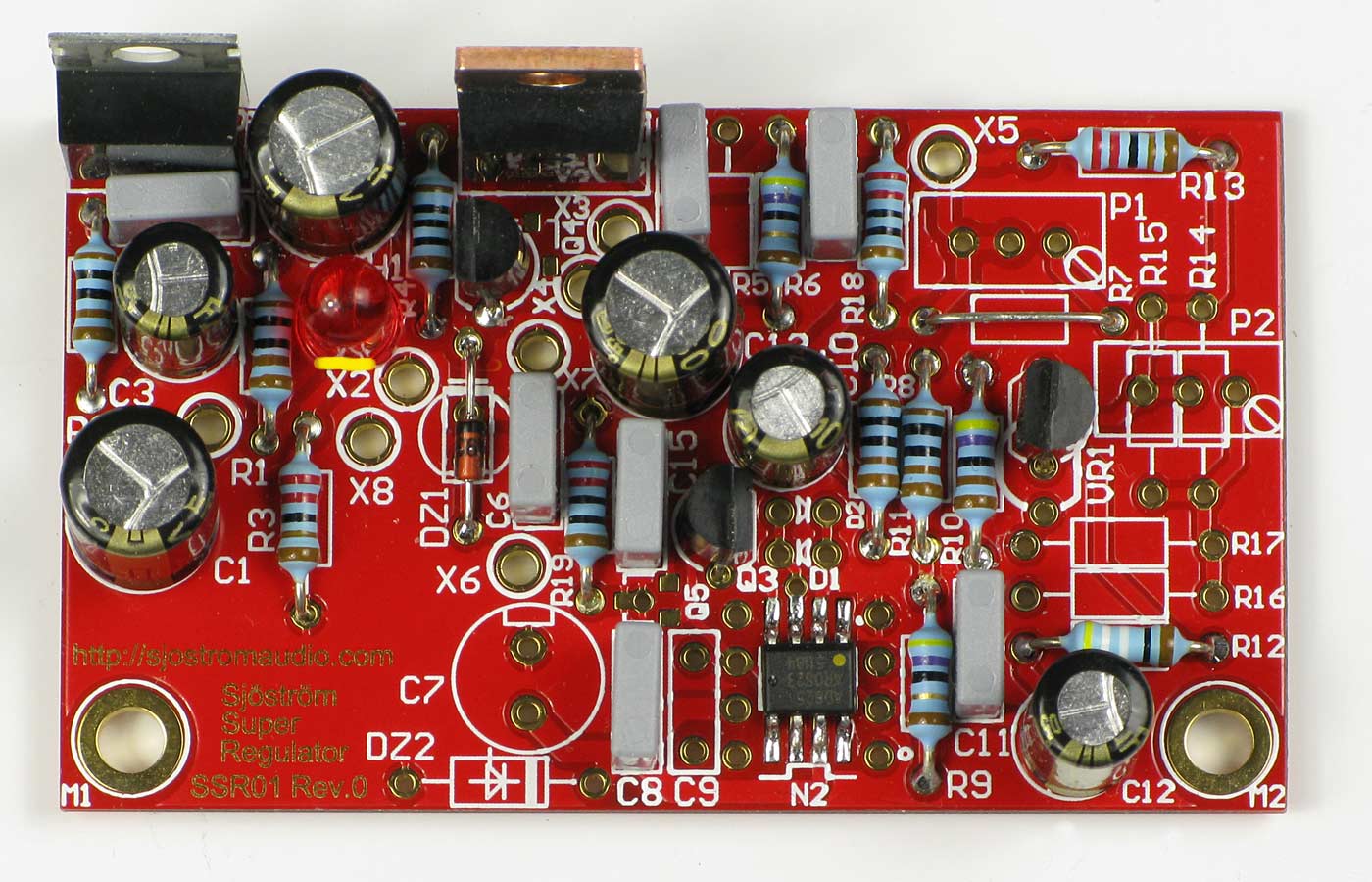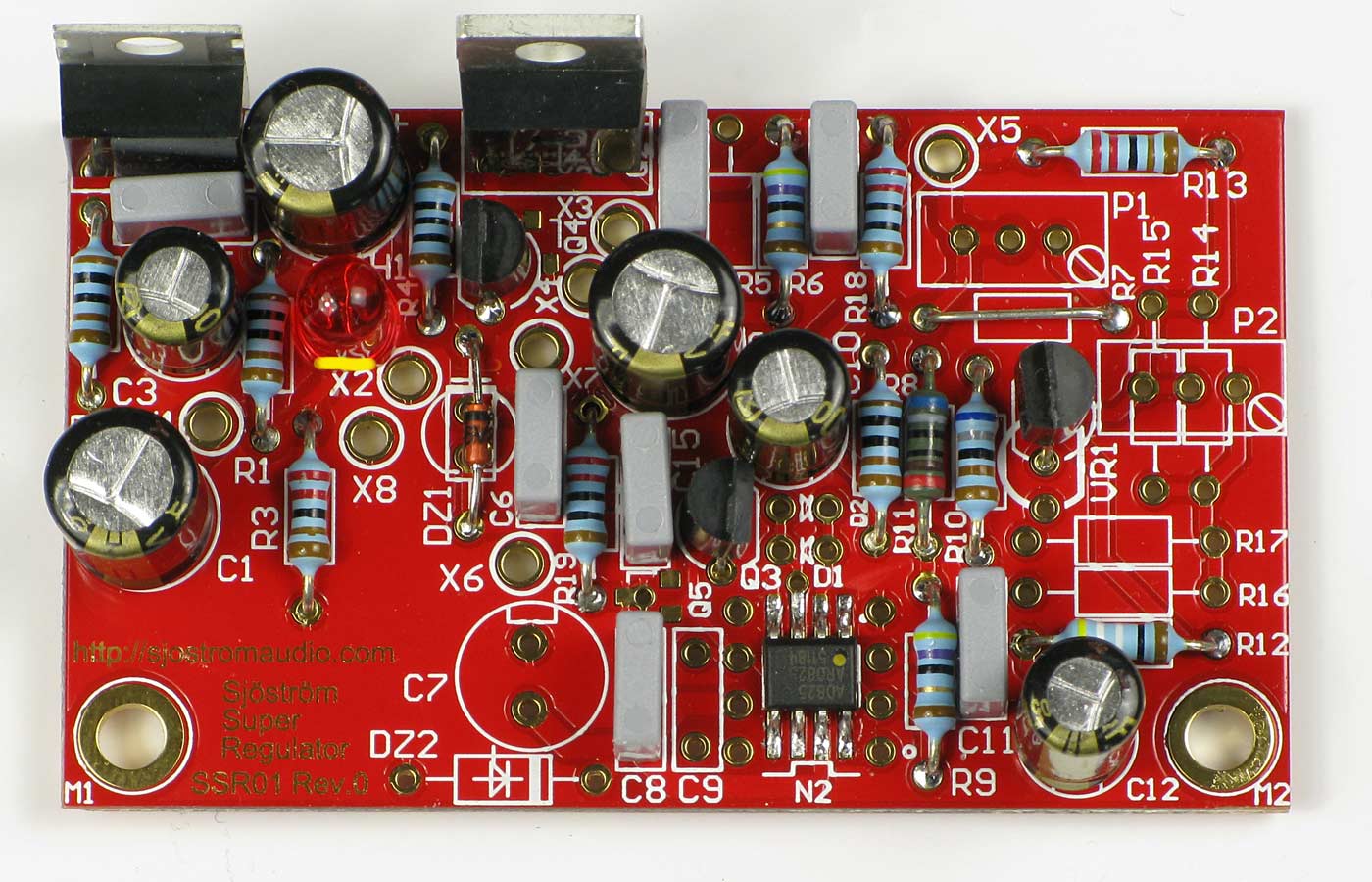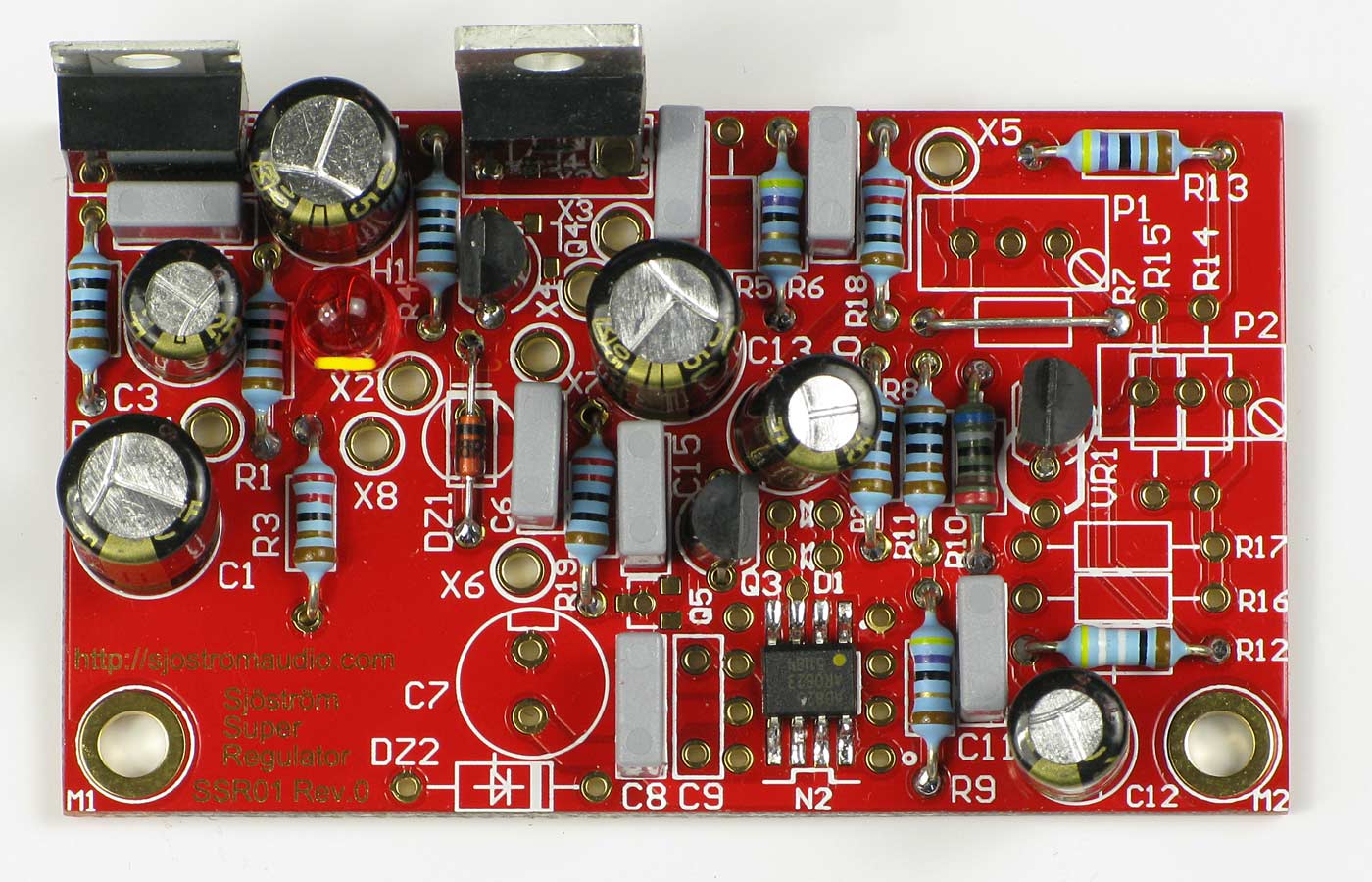SSR-01 The Sjöström Super Regulator
Click on the picture to get a larger view.
Some background can be found in my JSR-01 project.
This design is based on my JSR-01 project and the goal was to make the pcb with hole mounted parts as small and versatile as possible.
Interesting features
- 4-layer pcb with 70 um (2 oz.) copper.
- Power traces 140 um!
- Gold pads.
- Extremely low noise.
- Extremely low output impedance in the audioband.
- Small size.
- Easy to change voltage, also to negative voltage but this particular design (pcb) requires two different pcb's, one for positive voltages and one for negative.
- Well-known and well-tested in serious and demanding applications.
- Option for TO92 or SOT23 transistors for the small signal transistors.
- Option for DIL08 or SO08 opamp.
- LM431 (and similar) reference or devices like LM329. The pcb has a universal footprint.
- Trimming options for both the reference and the feedback. Room for extra resistors and trimpots.
- One output with sense inputs.
- All resistors 10 mm so it is possible to use a cut and bending machine for those parts.
- Option for using higher voltage than the max supply voltage for the opamp.
The background
This design has been known at www.diyaudio.com and elsewhere and it has been bescribed thoroughly in couple of articles in The Audio Amateur and also in other magazines, like EDN. The design presented below is a developed/altered version (not necessarily better) and not identical to the one in the articles nor to the pcb from Audio Express. Some of the changes has Andrew L Weekes done and some have I done.
Changes Walt Jung -> Andrew Weekes
Andrew added the preregulator and redesigned the pcb and added a starground in a more clear way. He also made a higher quality pcb with thicker copper.
Changes Andrew Weekes ->Per-Anders Sjöström
- Added all parts around the preregulator.
- Added component print on the pcb.
- Added a footprint for SO08 opamps.
- Added compensation for the opamp.
- Added a footprint both LM431 and LM329.
- Added footprints for SOT23 transistors.
- Added trimming facilities, both with fixed resistors and with trimpots.
- 4 layer pcb with 70 um copper resulting in 140 um for all high current traces and a good grounding.
- Added parts for tying the sense inputs to the outputs.
- Added solder pads for the sense inputs if you wanted to "park" them and left them unused.
- Added option for using higher voltage than the max supply voltage for the opamp.
- Added option for feeding the opamp from before the pass transistor enabling a very low output voltage using opamps with not low enough supply voltage properties.
- Gold on all exposed copper surfaces.
- All connections for thick wires.
The regulator from 1961
The basic idea has been around for at least 62 years.
Bob Pease has dig up some info about the Philbrick tube super regulator . The circuit solution can be traced back to 1961 at least. Change all triodes to transistors and you'll see that this is really a super regulator.
The regulator from 1977
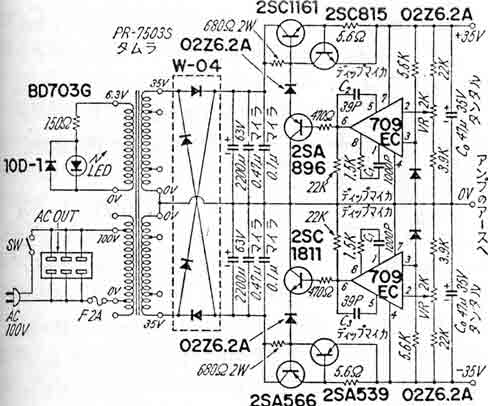
The Super Regulator from 1977, design by Mr. Kaneda.
An another example can be found in book written by Mr. Kaneda from 1977. What has changed since then? The zener references are nowadays much, much better and the opamps are even more much better. In other words there are great opportunities to increase the performance. One more change, rather important also is that the 680 ohms resistor at the top is changed to a constant current generator. This is very important for the output current capability also to the bandwidth, the speed of the regulator.
Is "Super" too much?
Does the design deserve the epithet "super"? Yes, indeed! Can anyone come up with any regulator with less noise and lower output impedance? I don't think so. I would be happy if someone can prove me wrong. This design is extreme in the true sense when it comes to these two parameters. I believe that a couple of more parameters also are state of the art.
I think this design is very interesting from an engineering point of view, a challenge to make it as good as it can be. Therefore I have decided to have it for spin.
Andrew L Weekes ALW has made a very good hole mounted pcb together with a very good documentation. He has also had a group purchase run at www.diyaudio.com and he came up with 700-800 pcb's, but he has left the DIY scene years ago for other activities but you can get his boards though.
aos (Andrija Ifkovic), has also made an pcb to a very good price but has stopped selling pcb's.
BrianGT (Brian Bell) has integrated the regulator in his DAC design. The thread is here. The design did never leave the computer.
The diyaudio.com user Coffin's friend has also made two pcb's, can't say how good they are but they looks nice at least.
There are also a couple of commercial sources, really expensive ones.
The design
The design is based nearly to 100% of the original super regulator. My contribution is transferring it to a more advanced pcb and making the pcb more universal. I have also made options for three different references. There will be no trouble at all to build the different versions since my cad program supports variants. If a variant is missing, please let me know and I'll maybe add it.
The schematics
Click on the picture to get a larger view.
I recommend that you download the schematics and print it so you can follow the describing text more carefully.
The pre-regulator
The first part is the pre-regulator (IC1), which has a rather odd connection. The sensing network, R1 and R2 is not connected to ground as usual. It's connected to the output so the LM317 regulates the voltage across the pass transistor Q2. The purpose of this is to create a constant voltage drop over this transistor. With this connection you will get a more flexible minimum input voltage which is 2.5 volts (according to the values of R1 and R2) plus the minimum voltage across the LM317 which is 2-3 volts. In total you will need approx. 5 volts more than the regulated output voltage.
The main purpose of this regulator is to increase the power supply rejection ratio, PSRR. If you of some reason don't want this pre-regulator just omit, C1-C3, R1, R2, IC1. Solder in a wire between Vin and Vout, pin 2 and 3. See the schematics. The rest of the regulator consists of a reference of some sort, opamp, output stage and feedback network.
The reference
As reference I have chosen to have maximum flexibility. Virtual any reference will fit as long as the voltage is above the common mode limit for the used opamp. 2.5-7 V will work and in some cases also down to 1.2 V. LM431 and LM329 is suported. Other references will work but check the pinout first. The LM431 (thick outline in the silkscreen print) has four resistors R14-R17 and a trimpotentiometer in order to trim the reference voltage.
The reference voltage is filtered by R12 and C11, C12 in order to remove the noise and as a side effect you will get a smooth startup. R12 should optimally be the value of the feedback network, (R7+R8)//R10//R11. //= means in parallel.
If you have 1k+1k in the feedback you can for the R12 either choose 499 ohms or simply solder two 1 kohms on top of each other. If you have matched input impedance's you will minimize the input offset and also the drift with temperature (not very important in audio applications). It may also be good when it comes to common mode rejection. Since the whole design is placed on a groundplane I gather that high frequency problems are not so big so you must take this into account. R9 and C9 are parts for "just in case", to customize the frequency properties. Normally R9 is only a wire jumper or a low value resistor and C9 is omitted.
The opamp
The opamp (N1) can be almost any type as long it's not too fast, faster than the output stage. The maximum speed of the opamp at unity gain is around 30-40 MHz. The AD825 has the bandwidth of 34-37 MHz at unity gain and the AD797 has unity gain bandwidth of approx. 30 MHz. If extremely low noise is important AD797 might be suitable but if "low" noise is sufficient I think any good audio opamp will do, like AD8610, OPA134 etc. Even good old NE5534 may work but I haven't tested this opamp. The only thing you must think of is the common mode limits for the inputs of the opamp. At start-up it's important that the opamp has predictable behaviour, especially sensitive is this for a negative regulator.
At the moment only AD797 and AD825 are tested for 5-24 volts, both positive and negative output voltages. Others have tested LT1028/LT1115 with good results.
Input protection of the opamp
D1 and D2 is input protection fo the opamp in case you can get differential voltages higher than the ratings, for instance at short circuit conditions. Under controlled conditions you can omit these diodes since they introduce an extra capacitance at the input.
Power for the opamp
You can either take the power from the output or before the pass transistor Q2. What you choose is dependent of used opamp and how low the minimum supply voltage is (see the datasheet for this parameter). Minimum voltage for AD797 is 10 volts so if you want to be really sure you must feed it from the unregulated side if you want less than 10 volts out. Parts which are involved in this are R5-R6 and C7, C8. The DZ2 must be used if the supply voltage is more than the maxium supply voltage of used opamp. The value of the zener should be lower than the maximum supply voltage of the opamp.
The feedback network
The feedback network is R7+R8 as the upper part. R7 is normally a wire and is used for trimming purposes. R10 in parallel of R11 is the lower part of the feedback and R10 is for trimming also. P1 can also be used if you want a variable output voltage, recommended if you use a fixed voltage reference like the LM329.
C10 reduces the gain and by this increase of the feedback which also reduces the output impedance. This capacitor is hardly necessary in real life (if the gain is 2) but if you want lower output impedance you should use it. The values of the feedback resistors should be a low as possible considering the max power dissipation. It serves two purposes. The first is to create a voltage divider with good high frequency properties (avoiding unstability) and also to draw current out of the pass transistor, Q2. If current flows all the time the output impedance can be kept low. It's also important for stability reasons.
The output voltage is determined by
Vout = Vref*(((R7//P1)+R8)/(R10//R11)+1)
The output stage
The output stage is rather unusual. Normally you have only one emitter follower, maybe together with a driver transistor forming a Darlington transistor. This type of output stage is rather slow. To speed things up the driver transistor (Q3) is changed to a class A emitter follower as the driver for the pass transistor (Q2). The load of the emitter follower (Q3) is a current source formed by a reference voltage, the LED H1 (makes a nice glow) and R14 together with T1. The current through the LED should be 1-3 mA. If you want very low voltages you must change the value of R3. A side effect of the LED H1 is that you will get an indication when you have enough input voltage.
The driver is also a bit backwards. This creates a very special and also very important feature, the possibility to a safe power up of the opamp. The output stage deliver max output voltage when the opamp is inactive. This makes the opamp come alive. The zener DZ1 increases the startup voltage and creates also a necessary DC shift so the output of the opamp works at ideally at half the output voltage. This zener voltage must be decreased when lower output voltages are wanted. For 5 volts it's sufficient with a LED in the forward direction, creating only 1.6 volts. Q3 is added compared to Walt Jung's original (but Mr. Kaneda had it) and unloads the opamp from the drive currents. C6 takes down the impedance of the zener.
No short circuit limiting
I have increased the current of the driver Q1 and T3, for higher speed but this makes also the regulator more vulnerable against short circuit so I suggest you are careful when you are connecting. It is possible to destroy the regulator but the LM317 (IC1) has current limitation 1.5 amps but still you must be carefull. Adding short circuit protection will increase the output impedance if you not implement an advanced circuit which requires lot's of pcb space.
Capacitive load and C13
The faster opamps you have, the more sensitive against capacitive load the regulator will get, meaning low loss capacitive load. The regulator has a minimum load of 0.3-0.5 ohms and if you have a 100 nF connected very close to the output transistor you can get an impedance lower than 0.5 ohms. This frequency will be at 3 MHz. Therefore the C13 must not be too "good". In fact a "normal" cap is sufficient and if you choose a low impedance cap you may experience unstability. If you use a fast opamp, it simulates a cap rather high up in frequency so serious decoupling this close to the output transistor isn't necessary but if you only have 30 mm wire the regulator can take 100 nF or more. The short wire creates a small inductance which is sufficient in order to limit the lowest impedance.
The "sense" connections
The sense connections are a bit overkill but if anyone wants these I have added this feature. The sense function is mainly to subtract or eliminate the losses in the power wires, which won't be especially large. It's just milliamps. If you want this feature make sure that the sense wires are close to the power wires so instability can be avoided. If you don't want to use this feature, just put two tin jumpers on the pcb solder side, marked J1 and J2. If you are sure that you never will use the sense function you can also omit R18, R19, C14 and C15.
The pcb layout
Click on the picture to get a larger view.
Please download the pdf of the pcb layout for more info.
The pcb is made of 70 um (2 oz.) copper and all traces which will carry high currents are doubled. They are on both sides and the nets involved (see the schematics) are Uin, Pre_reg_out and Uout. The pcb consists of four layers (which is unique!) and the two inner layers are dedicated for power ground and signal ground. The advantage is that the pcb can have two whole ground planes without any traces. The signal ground is very sensistive and is the key to the very good performance of this compact pcb. The other two layers have traces and power ground but the ground planes are on those layers a bit more divided.
In several places there are room for alternative parts such as SOT23 transistors (Q4, Q5), DIL08 opamp (N2) and voltage references VR1. Thin outline is for LM329 and bold outline LM431 and other pin compatible parts.
My design is in the top of super regulators in the market and one of the best in "jackinnj"'s test in Linear Audio's big regulator test. It's worth noticing that not every regulator had the super regulator topology.
Assembly instructions
Heat demanding
The pcb has four layers and therefore it requires much more heat than regular two-layer pcb. Ecpecially the ground connections are heat demanding (pads with a "star"). Use a 50 watts (at least) temperature controlled soldering iron and warm the pad so it really melts and tin flows to the component side. As you can see in my pictures I haven't succeeded to make 100% perfect solder joints and especially hard are the ground connections. If you check the R3, here I should have burned with the soldering iron a lot more. You can warm up the pcb with a hot air gun if you have a weak soldering iron. This will make a lot better result. It's not crucial for the function to have tin through the hole since they are plated.
Besides from these instructions the regulator is pretty easy to build but pay attention how you should mount all polarized parts. See pictures below and also the pdf file. In the pdf file I have made placement pictures with extra clear markings for each part. Print it and have it beside you when you solder.
This design is very easy to build. . You can solder the parts in the order you'll like but it may be practical to start with all low parts such as resistors and then take higher parts.
Assembly order
Start with all low parts except for the output power amp and the opamp. Suitable order can be like this:
Opamp
If it's a SMD type, start with opamp. It's hard to solder if you have any parts around the opamp. Put tin on any corner pad, like 1, 4, 5 or 8. Place the opamp and adjust so it is sitting straight. The solder the rest of the pads.
Resistors, jumpers
Solder all resistors. Use cut off resistorwires as jumpers.
Zener diodes
- Opamp if it's a SMD type. It's hard to solder if you have any parts around the opamp.
- Resistors, jumpers
- Zener diodes
- Plastic capacitors
- Transistors, voltage reference. Fat outline = LM431. Thin outline = LM329 or other 2-pin devices.
- LED
- Trim pot (if you use it)
- Capacitors, elelctrolytic
- Regulator, power transistor
5 V with LM431
Click on the picture to get a larger view.
The yellow stripe is cathode or the short leg of the LED. Notice also the yellow dot at the opamp.
9 V with LM431
Click on the picture to get a larger view.
The yellow stripe is cathode or the short leg of the LED. The zener DZ1, cathode up. Notice also the yellow dot at the opamp.
12 V with LM431
Click on the picture to get a larger view.
The yellow stripe is cathode or the short leg of the LED. The zener DZ1, cathode up. Notice also the yellow dot at the opamp.
15 V with LM431
Click on the picture to get a larger view.
The yellow stripe is cathode or the short leg of the LED. The zener DZ1, cathode up. Notice also the yellow dot at the opamp.
18 V with LM431
Click on the picture to get a larger view.
The yellow stripe is cathode or the short leg of the LED. The zener DZ1, cathode up. Notice also the yellow dot at the opamp.
24 V with LM431
Click on the picture to get a larger view.
The yellow stripe is cathode or the short leg of the LED. The zener DZ1, cathode up. Notice also the yellow dot at the opamp.
9 V with LM329
Click on the picture to get a larger view.
The yellow stripe is cathode or the short leg of the LED. The zener DZ1, cathode up. Notice also the yellow dot at the opamp. The LM329, VR1 is placed in the alternative position with a thin outline.
12 V with LM329
Click on the picture to get a larger view.
The yellow stripe is cathode or the short leg of the LED. The zener DZ1, cathode up. Notice also the yellow dot at the opamp. The LM329, VR1 is placed in the alternative position with a thin outline.
15 V with LM329
Click on the picture to get a larger view.
The yellow stripe is cathode or the short leg of the LED. The zener DZ1, cathode up. Notice also the yellow dot at the opamp. The LM329, VR1 is placed in the alternative position with a thin outline.
18 V with LM329
Click on the picture to get a larger view.
The yellow stripe is cathode or the short leg of the LED. The zener DZ1, cathode up. Notice also the yellow dot at the opamp. The LM329, VR1 is placed in the alternative position with a thin outline.
24 V with LM329
Click on the picture to get a larger view.
The yellow stripe is cathode or the short leg of the LED. The zener DZ1, cathode up. Notice also the yellow dot at the opamp. The LM329, VR1 is placed in the alternative position with a thin outline.
Test
If you don't plan to use the "sense" function, put a tin blob on the solder side at J1 and J2 (see the schematics also).
- Use a regulated power supply and set the current limit to 50-100 mA or something low.
- Connected a voltmeter at the output.
- Turn up the voltage slowly and observe the output and the current consumption. When the LED H1 starts to shine you should have a stable output voltage.
- Add a load to check is the voltage still is stable including some warm-up of the opamp and the voltage reference (a few millivolts).
If you have the preregulator LM317 installed the output voltage should be stable with 4-5 volts more in than set output voltage.
Technical data
| Operating voltage: | Max 50 V, less current at high voltage in. Min 4 volts more than output voltage. |
| Output voltage: | 5-40 V, down to 3 volts is possible. |
| Hum and noise at full output current: | Down to 0.9 µV or below depending of component choices |
| Max current: | Approx 1 A peak |
| Max continuous current: | Approx 1 A depending of ambient temperature and mounting (cooling). |
| Dimensions: | 66,0 (2.6") x 38,1 (1.5") mm |
Measurements are done by Jack Walton, jackinj, with an Audio Precision measurement system.
| Used parts | LM329, AD825 | LM329, AD797 | LM329, LT1028 |
| No filter: | 15.14 µV | 5.67 µV | 6.95 µV |
| A-Weighted: | 2.38 µV | 1.03 µV | 1.00 µV |
| CCIR-486: | 6.40 µV | 2.04 µV | 2.02 µV |
| CCIR-2K(Avg): | 3.03 µV | 0.941 µV | 0.921 µV |
| 22-22K: | 3.52 uV | 2.37 uV | 1.70 uV |
